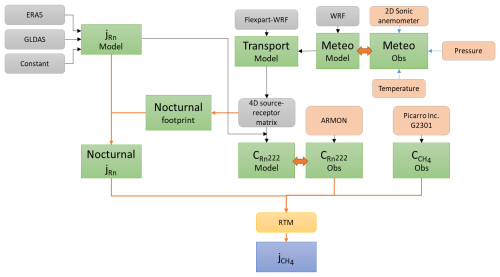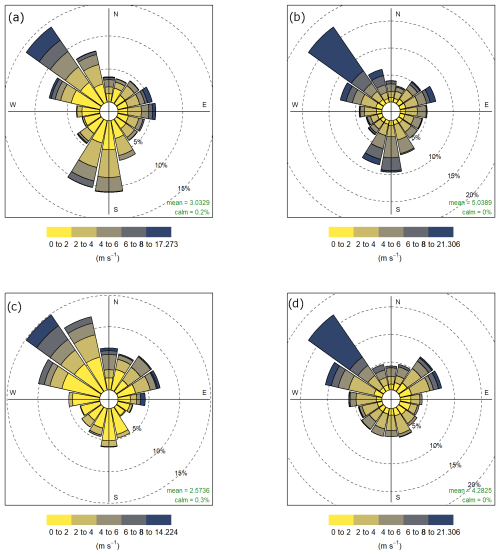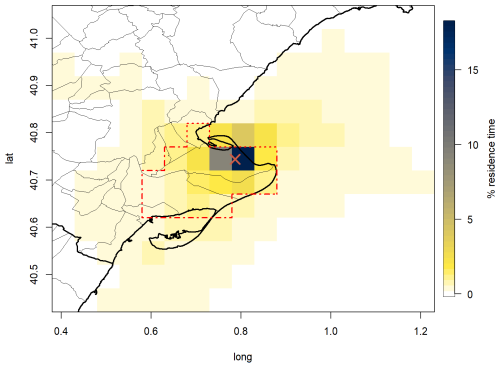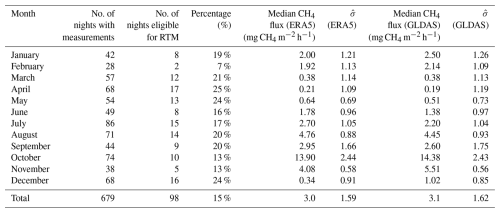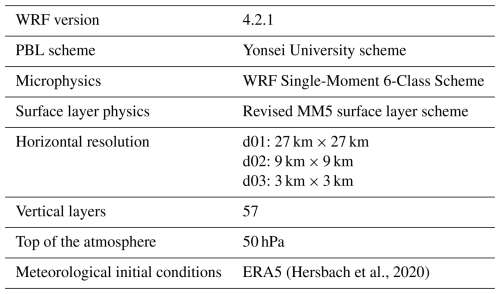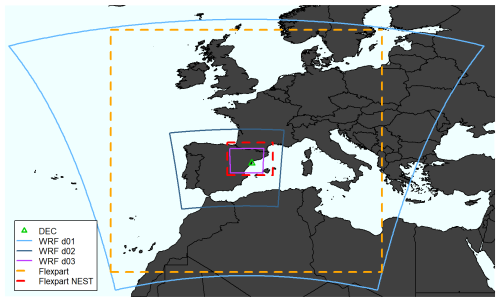the Creative Commons Attribution 4.0 License.
the Creative Commons Attribution 4.0 License.
Estimation of seasonal methane fluxes over a Mediterranean rice paddy area using the Radon Tracer Method (RTM)
Alba Àgueda
Josep-Anton Morguí
Lídia Cañas
Sílvia Borràs
Arturo Vargas
Claudia Grossi
The Ebro River Delta, in the northwestern Mediterranean basin, has an extension of 320 km2 and is mainly covered by rice fields. In the framework of the ClimaDat project, the greenhouse gases atmospheric station DEC was designed and installed in this area in 2013. The DEC station was equipped, among other tools, with a Picarro G2301 instrument and an ARMON (Atmospheric Radon Monitor) to measure both CH4 and CO2 and 222Rn concentrations, respectively.
The variability of methane fluxes over this area and during the distinct phases of the rice production cycle was evaluated in this study using the Radon Tracer Method (RTM). The RTM was carried out using (i) nocturnal hourly atmospheric measurements of CH4 and 222Rn between 2013 and 2019 and (ii) FLEXPART-WRF back trajectories coupled with radon flux maps for Europe with a resolution of 0.05° × 0.05° available thanks to the project traceRadon. Prior to the calculation of methane fluxes by RTM, the FLEXPART-WRF model and the traceRadon flux maps were evaluated by modelling atmospheric radon concentrations at the DEC station and comparing them with observed data.
RTM-based methane fluxes show a strong seasonality with maximums in October (13.9 mg CH4 m−2 h−1), corresponding with the period of harvest and straw incorporation in rice crop fields, and minimums between March and June (0.2 to 0.6 mg CH4 m−2 h−1). The total estimated methane annual emission was about 262.8 kg CH4 ha−1. These fluxes were compared with fluxes directly measured with static accumulation chambers by other researchers in the same area. Results show strong agreement between both methodologies, having both a similar annual cycle and similar monthly mean absolute values.
- Article
(2270 KB) - Full-text XML
-
Supplement
(2835 KB) - BibTeX
- EndNote
Globally averaged surface CH4 concentrations rose from 722±25 ppb in 1750 to 1927±2 ppb in 2023, and in the last years (2020–2023), the global methane concentration has increased an average of 15 ppb yr−1 (Lan et al., 2024). The causes of this increase are varied and still have large uncertainties (Drinkwater et al., 2023). The main driver of the methane trend over the last decades is known to be anthropogenic activity (Skeie et al., 2023), such as agriculture, fossil fuels combustion and decomposition of landfill waste. In addition to the direct methane emissions into the atmosphere, methane increase is also driven by CO and NOx emissions, which change the atmospheric oxidation capacity and hence atmospheric methane lifetime (Wuebbles and Hayhoe, 2002). A reduction in all anthropogenic methane sources is therefore mandatory to reduce the increase in concentrations and reach the Paris Agreement (Schleussner et al., 2016).
Particularly, in the case of agriculture, it is known that over the past 110 years global CH4 emissions from rice cultivation have increased by 85 % due to rice field expansion and nitrogen fertilizers use (Zhang et al., 2016). Global rice fields are estimated to emit between 18.3±0.1 and 38.8±1.0 Tg CH4 yr−1, with emissions varying based on different water management practices (Yan et al., 2009; Zhang et al., 2016). Rice field methane emissions follow a strong seasonality mainly due to management practices. Flooded rice paddies and wetland environments have a predominantly oxygen-free (anoxic) soil profile. In these ecosystems, CH4 is produced by methanogenic bacteria that digest organic matter under anaerobic conditions (methanogenesis) (Zhang et al., 2016). Atmospheric CH4 concentrations measured in the lower boundary layer of these ecosystems result from a combination of processes, including diffusion, ebullition and transport through aerenchyma of the plants. This methane originates from the net CH4 produced at the soil–water and soil–atmosphere interfaces of the ecosystem, further influenced by both positive or negative contributions due to the atmospheric mixing and advective transport from remote areas.
So far, many studies have investigated the different factors and variables controlling methane emissions from rice paddies, including both environmental and agricultural considerations. As an example, it has been observed that during the crop cycle these factors may include soil and air temperature, soil redox potential, water management, organic amendment, or fertilizer management (Oo et al., 2015; Pereira et al., 2013; Sass et al., 1991; Seiler et al., 1983; Wang et al., 2018; Yan et al., 2005). In recent years, some efforts have been made to also monitor CH4 emissions during fallow periods of rice soils. This includes investigations into the impact of straw management practices (e.g. incorporation into the field, removal from the field or burning) and flooding practices after harvest, as these can substantially influence emission levels (Alberto et al., 2015; Martínez-Eixarch et al., 2018; Fitzgerald et al., 2000; Belenguer-Manzanedo et al., 2022).
The results of these studies may be of great utility to understand emission differences due to diverse agricultural practices and soil characteristics, thus offering valuable insights for improving agricultural techniques and protocols. In addition, such studies are needed to improve emission inventories as well as methane emission models.
Nowadays various approaches have been applied to estimate CH4 emissions from rice fields. These approaches include direct flux measurements using techniques such as the eddy-covariance method (e.g. Alberto et al., 2015; Iwata et al., 2018; Runkle et al., 2019), accumulation chambers (Martínez-Eixarch et al., 2021; Wassmann et al., 2000), or measurements of methane both below and above the canopy (Simpson et al., 1995). A combination of all these techniques (Meijide et al., 2011) has also been valuable to provide a comprehensive understanding of CH4 emissions. Top-down techniques have also been used to estimate methane fluxes on rice fields, such as aircraft measurements (Desjardins et al., 2018; Peischl et al., 2012) or inversion models from atmospheric measurements (Thompson et al., 2015) or satellite data (Chen et al., 2022). However, in studies where several approaches are used, some disagreement has been found, mainly due to the uncertainties associated with atmospheric transport models or the accuracy of the emissions inventories (Desjardins et al., 2018; Cheewaphongphan et al., 2019).
One of these previous methods is the one known as the Radon Tracer Method (RTM). The RTM has been used in different sites for the retrieval of fluxes of greenhouse gases (GHGs) and other trace gases (Grossi et al., 2018; Levin et al., 2011; Schmidt et al., 1996; Vogel et al., 2012). The RTM uses co-located atmospheric observations of the noble gas 222Rn and the gas of interest, in this case CH4, together with modelled values of 222Rn fluxes. The utility of this method has been confirmed in recent years, and the Integrated Carbon Observation System (ICOS) is currently including atmospheric radon measurements within its network for offering GHG fluxes based on RTM applications. Actually, an interactive tool to apply the RTM to estimate GHG fluxes from ICOS atmospheric concentration measurement was developed as reported by Yver-Kwok et al. (2024). However, because a harmonized protocol for the RTM application is not yet available, researchers are now focusing on evaluating RTM limitations to improve its application worldwide (Levin et al., 2021; Yver-Kwok et al., 2024).
In the present work, methane fluxes over a rice paddy area, located in the Ebro River Delta, were estimated during different phases of the rice cultivation cycle. The estimation was conducted using the RTM, which was applied in the frontier region of the Ebro River Delta, and a validation of the methodology was also performed.
The present work presents the area of study and the methodology applied in Sect. 2. In Sect. 3 the hourly radon and methane atmospheric measurements are firstly presented, together with (i) hourly modelled atmospheric radon concentrations and (ii) RTM-based methane fluxes. The reliability of the radon flux maps and transport models used for the area and period of interest was also evaluated and is presented in this section. Finally, CH4 fluxes obtained with the application of the RTM were compared with fluxes from known emission inventories (i.e. EDGAR) and previous research studies based on different methodologies.
Here the full methodology and the different steps designed and realized for the calculation of methane fluxes over the Ebro River Delta are presented. Figure 1 shows a scheme of the different inputs and outputs participating in this process, as will be explained in detail in the following subsections.
2.1 Site description: Ebro River Delta
The Ebro River Delta (ERD), with an extension of 320 km2, is located at the Ebro River mouth, on the Spanish coast of the western Mediterranean basin. Its main land use is rice field (70 %), followed by beaches, salt marshes, dunes and coastal lagoons, according to the CORINE Land Cover inventory (European Union, 2018) (see Fig. S1 in the Supplement).
The ERD experiences strong winds coming from the north of Spain and channelled through the Ebro River watershed (Gangoiti et al., 2002; Valdenebro et al., 2011). These winds cross the valley between the Iberian system and the Pyrenees. The wind regime in the ERD is also dominated by land–sea breeze phenomena, with winds coming from the sea during the day and land–sea breezes at night (Martín et al., 1991).
The ERD has a typical Mediterranean climate with mild winters and warm summers (Casanova, 1998). Wind blows with high mean annual velocities (>8 m s−1) during the entire year (Generalitat de Catalunya, 2022) and blows predominantly from the NW in winter (e.g. Casanova, 1998), and from the south–southeast in summer (Generalitat de Catalunya, 2022). The atmospheric relative humidity is high over the entire year (>65 %) (e.g. Grossi et al., 2016).
The ERD has a flat orography, with approximately 60 % of its total area having elevations lower than 1 m above sea level (a.s.l.) (Generalitat de Catalunya, 2022). Two main canals flank the river, distributing water across a network of smaller canals. Rice paddies cover an extension of more than 200 km2 and represent 83 % of the total crop area in the Ebro Delta.
Figure 2 presents a Gantt diagram, adapted from Àgueda et al. (2017), outlining the main anthropogenic activities conducted in the ERD rice fields. It is important to note that the timing of these activities may vary slightly from year to year due to the weather seasonality or changes in management practices.
Rice fields in the ERD remain completely flooded during the majority of the growth cycle, with a water column typically ranging from 8 to 15 cm (Alvarado-Aguilar et al., 2012). Prior to irrigation, usually in mid-April, the land is prepared (tilled and levelled) and fertilized. After the flooding, direct sowing takes place between mid-April and mid-May, and plants grow until mid-August, marking the onset of harvesting. After harvest, rice straw is incorporated into the soil using mechanical means. In some years, flooding with seawater of some of the rice fields was carried out during winter months in order to cope with an Ampullariidae plague.
2.2 Atmospheric observations
An atmospheric station in the Ebro Delta (DEC; 40.74° N, 0.79° E; 7 m a.s.l.) was built in 2013 within the ClimaDat project (Grossi et al., 2016; Morgui et al., 2013). The station was built next to the Canal Vell biological station, in the middle of the ERD, surrounded by rice fields (black asterisk in the right panel of Fig. S1 in the Supplement). At the DEC atmospheric station, GHG (CO2, CH4, N2O, CO), atmospheric radon and meteorological variables (see Sect. 2.2.4) were continuously measured at a 10 m above ground level (a.g.l.) tower. Due to the extreme humidity conditions and salty air at the DEC site, sampling pumps continuously broke over the years, and thus only 30 % of the days in the sampling period (2013–2019) has the full record of 222Rn, GHG, and meteorology variables.
2.2.1 Atmospheric radon measurements
The atmospheric concentrations of the radioactive and noble gas radon (222Rn) were hourly measured at the DEC station using a first version of the Atmospheric Radon Monitor (ARMON), designed and calibrated by researchers of the IONHE (Ionizing Radiation, Health and Environment) group of the Institute of Energy Techniques (INTE) of the Universitat Politècnica de Catalunya (UPC, Spain). The ARMON is based on the alpha spectrometry of positive ions of 218Po, coming from the radon decay within the detection volume, collected on a passivated implanted planar silicon (PIPS) detector surface by an electrostatic field (Grossi et al., 2012; Vargas et al., 2015). The ARMON is capable of distinguishing between 222Rn and 220Rn (thoron) contribution and, with an integration time of 1 h, has a detection limit of 0.132 Bq m−3 and a total uncertainty of around 10 % for average concentrations of about 5 Bq m−3 (Curcoll et al., 2024; Röttger et al., 2025). This type of monitor was installed at several Spanish stations (Grossi et al., 2016), and its response and performance have been compared with those of other radon and radon progeny monitor types (Grossi et al., 2016, 2020; Röttger et al., 2025).
Due to the fact that the collection efficiency of 218Po on the detector surface is strongly influenced by the humidity of the sampled air, a low-maintenance drying system was designed and installed at the DEC site (see Sect. 2.2.3). Moreover, to address this influence, a linear water correction factor was empirically determined and applied following the methodology outlined by Grossi et al. (2012).
2.2.2 Atmospheric CH4 measurements
CH4 measurements were continuously performed by a G2301 gas concentration analyser (Picarro Inc., USA). This device is based on the cavity ring-down spectroscopy technique (CRDS) (Crosson, 2008) and offers simultaneous and precise measurements of CO2, CH4 and H2O every 5 s. Hourly mean values were used in this study.
During the measurement period the Picarro G2301 analyser was calibrated every 2 weeks using four secondary working gas standards, which were calibrated at the beginning and at the end of their lifetime against seven standards of the National Oceanic and Atmospheric Administration (NOAA). Calibration scales were WMO-X2019 (Hall et al., 2021) and WMO-X2004A (Dlugokencky, 2005) for CO2 and CH4, respectively. A fifth target gas was analysed daily for 20 min in order to check the stability and quality of the instrument calibration. Precision of the instrument for methane was better than ±0.3 ppb and accuracy better than ±1 ppb.
Although the instrument at the DEC site was measuring dried air, a water correction factor was applied for better accuracy of the measurements following the MPI-Jena method (Rella et al., 2013).
2.2.3 Drying system
As previously noted, water vapour content has an important influence on Picarro Inc. measurements (Rella et al., 2013; Reum et al., 2017) as well as radon measurements with ARMON (Grossi et al., 2012; Curcoll et al., 2024). Moreover, the extreme weather conditions at the ERD during the summer season, characterized by temperatures surpassing 30 °C and relative humidity levels reaching 80 %, highlight the need for sample drying to prevent water condensation in the pipes or the instruments. To address this concern, an automatic circuit was developed at the DEC station to dry the air sample before it entered the instruments. The sampled air (2.5 L min−1) was passed through a Nafion® membrane (Permapure, PD-100T-24MPS) exchanging water molecules with a dry counter-current air flow. The counter-current air flow was generated in a two-step process, first flushing air through a cooling coil in a refrigerator at 3 °C and a gauge pressure of 5.5 bar and then through a cryotrap at −70 °C and a pressure of 1.5 bar. Multiple cryotraps were selected with electrovalves to increase the autonomy of the system to approximately 2 months. After the Nafion membrane, the air sample had a water vapour concentration between 100 and 400 ppm. At this point, the flow was divided: 2 L min−1 was sent directly to the ARMON, and the rest was passed through a cryotrap in order to reduce the water content up to 10 ppm for the Picarro Inc. G2301 instrument.
2.2.4 Meteorological observations
Meteorological variables were continuously measured at the DEC tower. The tower was equipped with (1) a two-dimensional sonic anemometer (WindSonic, Gill Instruments) for wind speed and direction (accuracies of ±2 % and ±3°, respectively); (2) a humidity and temperature probe (HMP 110, Vaisala) with an accuracy of ±1.7 % and ±0.2 °C, respectively; and (3) a barometric pressure sensor (61302V, Young Company) with an accuracy of 0.2 hPa (at 25 °C) and 0.3 hPa (from −40 to +60 °C). All the accuracy factors previously mentioned refer to manufacturers' specifications.
2.3 CH4 flux estimation using the Radon Tracer Method (RTM)
The Radon Tracer Method (RTM) was applied in this work to obtain nocturnal methane fluxes [mg CH4 m−2 h−1] over the footprint area covered by the DEC station. The RTM uses atmospheric concentration measurements of 222Rn [Bq m−3] and the target gas (here, CH4 [mg CH4 m−3]) together with simulated values of 222Rn fluxes [Bq m−2 s−1]. This method, described in detail in the works from Grossi et al. (2018), Levin et al. (2011, 2021), Schmidt et al. (1996) or Vogel et al. (2012), is based on the assumption that the nocturnal lower atmospheric boundary layer can be described as a well-mixed box of air. The nocturnal boundary layer effective height (h(t)) is considered homogeneous within the box, and horizontal advection is considered negligible under stable atmospheric conditions (Griffiths et al., 2013). Thus, within this atmospheric volume the variation of the concentration of any tracer (represented with the subindex i) with time is proportional to the flux of the tracer itself ji(t), inversely proportional to the height hi(t) and homogenous within the volume (see Eq. 1).
In the case of 222Rn we should also consider its decay by including a decay constant (λRn; [s−1]) (see Levin et al., 2021).
If the RTM methodology is applied for single nocturnal windows, the gas fluxes may be taken as constant within each individual nocturnal window, and finite temporal concentration increases (or slopes) of the measured gases may be used. Finally, as both gases are measured at the same point, the effective height h(t) may be the same for both. Combining Eq. (1) for the measured target gas (CH4) as well as for 222Rn, the term h(t) can be removed, obtaining Eq. (2), where the target gas flux can be calculated.
In Eq. (2), for each night, jRn is the radon flux, ΔCRn is the radon atmospheric variability over the nocturnal window and is the methane atmospheric variability over the same time interval. Considering that applying the RTM during the nocturnal window the maximum change in 222Rn activity concentration due to radioactive decay is less than 10 %, which is much smaller than the uncertainties due to RTM and radon exhalation maps, the decay contribution of radon may be neglected (Levin et al., 2021), obtaining the simplified form in Eq. (3).
Thus, from Eq. (3), if the radon flux over the footprint area is known, the methane flux can be calculated knowing the temporal variation of radon and methane atmospheric concentrations measured during each nocturnal window.
To estimate the effective nocturnal radon flux over the footprint area (i.e. around DEC station), according to the methodology presented by Grossi et al. (2018), a window of 70 km × 70 km around it was selected as feasible influence area. The influence area for radon flux retrieval for every single night over the whole 2013–2019 period was calculated from the residence time of 6 h FLEXPART-WRF back trajectories from the DEC station. The setup of both WRF and FLEXPART models is described in Sect. 2.4.2. Representative back trajectories were run daily at 00:00 UTC, and only the layers next to the surface (0–200 m) and within the 70 km × 70 km window were considered. Three average radon flux values for every nocturnal event (denoted as jRn in Eq. 3) were derived by multiplying daily footprints by three different European radon exhalation maps (refer to Sect. 2.4.1).
As the RTM is based on the stability assumption, only night periods with specific characteristics were chosen in this study. The selection criteria were based on the following requirements:
-
A nocturnal window between 21:00 UTC and 03:00 UTC was selected for each single night analysis in order to use only nocturnal accumulation events.
-
A data selection criterion based on a threshold of R2≥0.5 for the linear correlation between 222Rn and CH4 concentrations was used to reject events with a low linear correlation between the atmospheric concentrations of both gases.
-
Only nights where both CH4 and 222Rn had a positive concentration gradient were selected, in order to retrieve only positive net fluxes under stable boundary layer conditions.
-
In order to evaluate the possible effect of advection signals for both radon and methane accumulations, the RTM was run only considering events both with wind speeds below 1.5 m s−1 and without wind speed restriction.
2.4 Evaluation of the reliability of RTM-based CH4 fluxes
As explained in the previous section, the RTM is based on some assumptions, but no harmonized protocols have been available for its applications so far. One of the main questions that arises when applying the RTM methodology is the representativeness area of the estimated fluxes. Levin et al. (2021) demonstrated that one of the main limitations of the RTM was that the quantitative comparison of RTM-based with bottom-up emission data was not directly possible without reliable footprint modelling of the night-time observations and that this may be hampered by the reliability of the transport model under nocturnal conditions (i.e. boundary layer height, wind speeds, etc.).
Before applying the RTM for the calculation of methane fluxes over the ERD area, the effective nocturnal radon flux term (denoted as jRn in Eq. 3) seen by the DEC station each night was estimated, in agreement with Grossi et al. (2018), using together the meteorological (WRF) and transport (FLEXPART-WRF) models. Additionally, as previously mentioned, three different radon exhalation maps were used to assess the results obtained for each of them (see Fig. 1).
To evaluate the performance of the FLEXPART-WRF and of the three radon flux maps (ERA5-Land, GLDAS-Noah and constant map, as explained later in Sect. 2.4.1) atmospheric radon concentrations at DEC were simulated for a whole year (2019). Simulated hourly radon concentrations were obtained using the output of the FLEXPART-WRF model to build a source–receptor matrix (Seibert and Frank, 2004), which was then coupled with one of the three different available radon exhalation maps. Modelled hourly radon concentrations were then compared with observed data measured by ARMON. Details of this procedure are explained in detail in the following sections.
2.4.1 Radon exhalation maps
Radon exhalation maps used in this study were obtained from the European radon maps developed by Karstens and Levin (2023) within the EMPIR 19ENV01 traceRadon project (Röttger et al., 2021). The theoretical equations applied to simulate the radon transport in the soil and its exhalation to the lower atmosphere are described in Karstens et al. (2015). It basically assumes that the transport of radon through the soil and across the soil surface into the atmosphere occurs predominantly by molecular diffusion, and it strongly depends on physical soil parameters and its water content (Nazaroff, 1992). The model uses soil uranium content (Cinelli et al., 2019), soil properties (Hiederer, 2013), and two different soil moisture reanalysis datasets – ERA5-Land soil moisture reanalysis (Muñoz Sabater, 2019) or GLDAS-Noah v2.1 soil moisture reanalysis (Beaudoing and Rodell, 2020). For this study, monthly data were used for the period 2013–2016, and daily data were used for the period 2017–2019, in accordance with model output availability. The horizontal resolution of these radon exhalation maps is 0.05° × 0.05°. Two radon exhalation maps were obtained using both ERA5-Land (ERA5) and GLDAS-Noah (GLDAS) datasets. In addition, a third radon exhalation map (Constant) was generated with a constant term exhalation from inland surface grid cells of 15.8 mBq m−2 s−1 and a zero radon exhalation flux for sea grid cells. These values were applied according to previous European studies (Arnold, 2009; Levin et al., 1999; Schmidt et al., 2001). Figure S2 in the Supplement shows average radon exhalation distribution for the period 2013–2019 for Europe and for the ERD area according to the three previous maps.
2.4.2 WRF and FLEXPART-WRF simulations for RTM
The Lagrangian particle dispersion model FLEXPART-WRF v.3.1 (Brioude et al., 2013) was used to calculate back trajectories from the DEC station. The original FLEXPART model (Stohl et al., 2005) was designed for calculating long-range and mesoscale dispersion of hazardous substances from point sources but evolved into a comprehensive tool for multi-scale atmospheric transport modelling and analysis (Pisso et al., 2019). In this work, we used the FLEXPART version that works with the inputs coming from the mesoscale meteorological model Weather Research and Forecasting (WRF; Skamarock et al., 2021). The decision of using a mesoscale model, such as WRF, for this study rather than a global model was made based on the dimensions of the ERD (15 × 22 km2) and the recognized importance of using high-resolution mesoscale models in coastal areas (Ahmadov et al., 2009; Hegarty et al., 2013). The FLEXPART-WRF v.3.1 model, referred to as Flex-WRF hereafter, has already been used in studies where global weather models may not reproduce the terrain-induced weather features correctly due to complex terrains (e.g. coastal sites or mountains) (Aliaga et al., 2021; Madala et al., 2016). The WRF model v.4.1 (Skamarock et al., 2021) was set up for this study with three domains (see Appendix A): (d01) Europe (spatial resolution of 27 km × 27 km); (d02) the Iberian Peninsula (spatial resolution of 9 km × 9 km) and (d03) northwestern Spain (spatial resolution of 3 km × 3 km). All domains had 57 verticals layers up to 50 hPa, and the meteorological initial and lateral boundary conditions were determined using ERA5 global model data (Hersbach et al., 2020). More details about the parametrization used for these simulations are shown in Appendix A.
WRF outputs were used as inputs within the Flex-WRF model to simulate back trajectories arriving at the DEC station inlet point (10 m a.g.l.). WRF outputs from all three domains were used. The back trajectories were run simulating the transport of 10 000 particles with time steps of 1 h. The output of this type of back trajectory simulations is the residence time of the particles in each 3D grid cell at every time step (1 h).
Flex-WRF back trajectories were used both to simulate the radon concentrations in DEC (see Sect. 2.4.3) and to retrieve the effective radon flux influencing the DEC station each night for the RTM application. For the radon concentration simulation, back trajectories of 8 d (192 h) were used. For the retrieval of the nocturnal effective radon flux, back trajectories length was set to 6 h.
The output domain of Flex-WRF (see Fig. A1) covered Europe and the North Atlantic region with a resolution of 0.1° × 0.1°, although a nested output domain of 150 km × 150 km around DEC station with a resolution of 0.05° × 0.05° (referred as FLEXPART NEST, Fig. A1) was also used. The vertical resolution of the output was from 0 to 5000 m height (17 levels). For the retrieval of nocturnal radon fluxes, only the nested domain was used.
From all the back trajectories, a 4D source–receptor matrix (Seibert and Frank, 2004) for particles arriving at DEC was obtained. A 222Rn decay ( d) was applied to the matrix in order to obtain the source–receptor matrix for 222Rn. The layers with influence for the source–receptor matrix were assumed to be only those below 200 m (Hüser et al., 2017).
Figure S3 in the Supplement shows two examples of the residence time of the fictitious particles calculated with Flex-WRF for two of the most typical synoptic situations using 192 h back trajectories.
2.4.3 Modelled hourly radon concentrations at the DEC station
The 8 d Flex-WRF back trajectories were run every hour for every day of 2019 in order to simulate hourly atmospheric radon concentrations at DEC for that year. Three radon concentration time series at the DEC station were then simulated every hour by multiplying the source–receptor matrix by each of the three different radon exhalation maps presented in Sect. 2.4.1 and dividing them by the height of the influence layer (i.e. 200 m), obtaining Flex-WRF-ERA5, Flex-WRF-GLDAS and Flex-WRF-Const time series, respectively. The largest domain from the back trajectory simulations was rescaled to 0.05° × 0.05° and merged with the nested domain to have the same resolution as the radon exhalation maps.
2.4.4 Statistical metrics to evaluate Flex-WRF-based 222Rn concentrations
For the quantitative evaluation of the goodness of the simulation of radon concentrations at DEC, the following metrics were calculated between simulated and observed hourly radon concentrations in 2019: the bias (BIAS), the correlation coefficient (R), the root mean square error (RMSE) and the weighted root mean square error (WRMSE). This last coefficient was calculated as in Eq. (4), and the weight was defined as the average value between observed and modelled values (Eq. 5). The WRMSE can better evaluate the performance of the models without giving too much importance to nocturnal overestimations or underestimations of concentrations due to a poor representativeness of the local boundary layer height (Arnold, 2009).
with
where refers to the measured values and to the modelled ones.
2.5 Literature review of CH4 fluxes in the ERD area
To assess the reliability of the methodology applied in this work, methane flux values derived from the RTM were compared against data from available databases, such as the Emissions Database for Global Atmospheric Research database (EDGAR), as well as from Spanish inventories and experimental studies (Martínez-Eixarch et al., 2018, 2021).
The EDGAR v.7.0 inventory, developed by the European Commission Joint Research Centre and the Netherlands Environmental Assessment Agency (European Commission, 2023), includes global anthropogenic emissions of GHGs and air pollutants by country on a spatial grid. The EDGAR version used in the present study provides monthly CH4 emissions on a 0.1° × 0.1° resolution for the period 2013–2019. All major anthropogenic source sectors (e.g. waste treatment, industrial and agricultural sources) are included in this inventory, whereas natural sources (e.g. wetlands or rivers) are excluded. The spatial allocation of emissions on 0.1° × 0.1° grid cells in EDGAR has been built up using spatial proxy datasets with the location of energy and manufacturing facilities, road networks, shipping routes, human and animal population density, and agricultural land use. Figure 3 shows the EDGAR inventory grid map extracted for a region centred over the ERD.
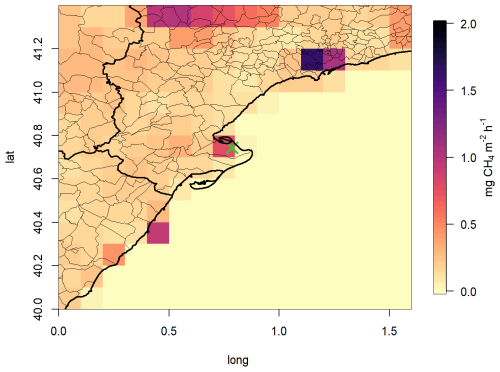
Figure 3Average methane fluxes around ERD station (150 km × 150 km) according to the EDGAR inventory v.7.0 for the period 2013–2019. The DEC station is indicated with a green cross.
National inventory reports establish, following the methodology of the IPCC Guidelines (Eggelston et al., 2006), an annual emission factor for rice crops as a function of a fixed term multiplied by a series of coefficients associated with fertilization management or length (in days per year) of rice crop production. The inventoried emissions also take into consideration the fallow emissions, although they distribute its emissions among the crop season. In the latest national inventory report of the UNFCC (National Inventory Report of Spain, 2023), Spain reported an average methane emission flux of 1.32 kg CH4 ha−1 d−1 for its rice crops during crop cultivation period (150 d), equivalent to 5.54 mg CH4 m−2 h−1 during the crop period and a total yearly emission of 198.5 kg CH4 ha−1. Following the IPCC methodology but for the Ebro Delta crop fields, the same value is obtained.
In 2015 and 2016 a multi-site field experiment covering the agronomic and environmental variability of the rice growing area of the ERD area was conducted by researchers of the Institute of Agrifood Research and Technology (IRTA, Spain) (Martínez-Eixarch et al., 2018, 2021) for evaluating the GHG emissions during the productive (June–October) and fallout (October–December) rice seasons. Static flux chambers were used in this study at 24 sampling points, covering both sides of the river and different rice varieties and fertilization management practices present in the area. Annual methane emissions obtained from these studies were 262.6±5.9 kg CH4 ha−1, equivalent to an average flux of 3.0 mg CH4 m−2 h−1.
3.1 Observed atmospheric concentrations of 222Rn and CH4 at the DEC station (2013–2019)
Figure 4 shows monthly average values of 222Rn and CH4 atmospheric observations measured at the DEC station during the period 2013–2019. Atmospheric CH4 concentrations show a pronounced seasonal trend, with maximums observed in the months of September, October and November, with monthly average concentrations between 2.2 and 2.4 ppm and minimums from March to July with monthly average concentrations below 2 ppm. The highest methane concentrations correspond to months of the year during which straw incorporation occurs, as reported in Fig. 2. Conversely, monthly averages of the atmospheric radon concentrations do not show any strong seasonality. In general, monthly mean values are below 4 Bq m−3, lower than those usually measured at continental sites (Grossi et al., 2016, 2018; Levin et al., 2021) but similar to those observed at coastal sites (Biraud et al., 2000; Vargas et al., 2015). Higher radon values are observed in December, as previously reported by Grossi et al. (2016) for the period 2013–2015 at the same station. This could be attributed to the arrival of northwestern winds from continental areas in the north of Spain to the DEC station, probably with air masses rich in radon in comparison with background levels (see Grossi et al., 2016).
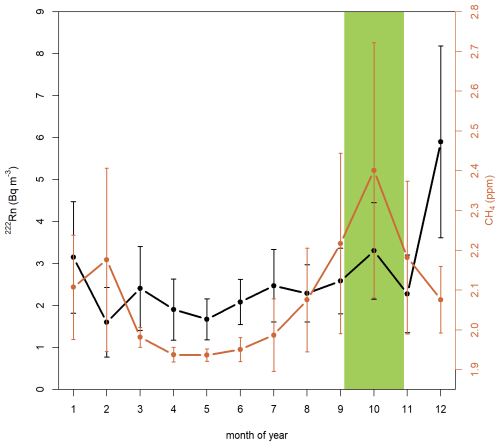
Figure 4Observed average annual cycle for radon (black) and CH4 (orange) concentrations at DEC within the 2013–2019 period dataset. Vertical whiskers represent variability (standard deviation) for each month. Green area corresponds to the “straw incorporation” period in the rice management cycle at ERD.
Average monthly diurnal cycles for both CH4 and 222Rn gases have been calculated for each month of the year over the whole 2013–2019 dataset (Fig. 5). Methane concentrations show a flat diurnal cycle from December to July. However, from August to November a more prominent methane diurnal cycle can be observed, with typical nocturnal accumulations and a decrease in concentrations after 06:00 UTC. This may indicate the accumulation, during nocturnal stable conditions, of local methane emissions. On the other hand, the hourly average radon concentrations show a more regular diurnal cycle throughout the year, with a daily maximum at 07:00 UTC and minimums in the afternoon. These asymmetric differences in the cycles between the two gases cannot be only explained by atmospheric conditions, and it could be due to seasonal differences in the source terms of the two gases, as will be analysed in more detail later.
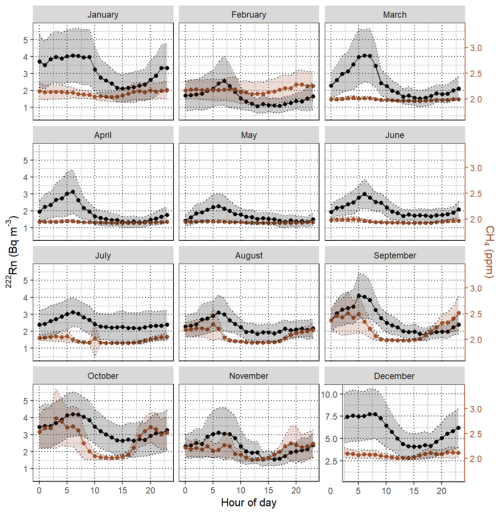
Figure 5Observed average monthly diurnal cycles for atmospheric radon (black line in Bq m−3) and methane (orange in ppm) at DEC within the 2013–2019 period dataset. Points are hourly averaged values. The shaded area is the standard deviation for both CH4 and 222Rn. Note the different 222Rn concentration scale for December.
Figure 6 shows average monthly wind roses for the period 2013–2019 elaborated using wind speed and direction measured at DEC tower (10 m a.s.l.). From the multiple plots, two main seasonal patterns in wind regime are observed. During winter months (November to March) strong northwestern winds coming from the Ebro valley are predominant, and in summer the predominant winds are softer sea breezes coming from south, in agreement with Cerralbo et al. (2015). This last observation may indicate that during the summer months the local source term of the two gases may have a larger impact on the observed concentrations and thus on their diurnal cycles than during the winter months.
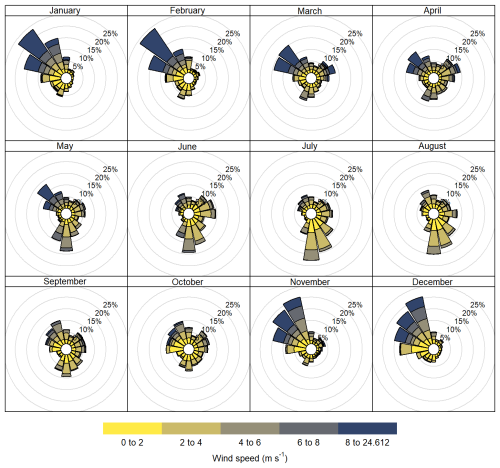
Figure 6Monthly wind roses for the upcoming winds at the DEC station (10 m a.g.l.) within the 2013–2019 period dataset.
Figure S4 in the Supplement presents monthly wind roses calculated for nighttime (21:00 to 03:00 UTC, same windows as for RTM) and midday (11:00 to 17:00 UTC). The southern winds are only present at midday and in warm months (May–October), as they are caused by the sea–land breeze. Northwestern winds in winter (November–March) are present day and night, although they are stronger at nighttime. In spring (April–May) and autumn (September–October), soft land–sea breezes at night and sea–land breezes during the day can be observed, although the signal is weak.
3.2 Radon flux term evaluation
To assess the reliability of RTM-based CH4 estimated fluxes, we have previously evaluated the radon flux term by assessing the performance of meteorological (WRF) and transport (FLEXPART-WRF) models. We also examined the footprint and the annual cycles of radon flux.
3.2.1 Meteorological model evaluation
Figure 7 shows a comparison between whole-day and nocturnal (21:00 to 03:00 UTC) wind patterns at the DEC station for 2019 from both experimental observations and WRF surface field outputs. Although direction patterns are quite similar, modelled winds seem to be stronger. The model seems to overestimate the wind speed with an average bias of 2.0 m s−1. The correlation factor found between simulated and observed wind speed is 0.57, and the circular correlation for wind direction is 0.52. The model seems to better simulate temperature and pressure, as the correlation between these simulated variables and the observed values at the DEC station is 0.89 and 0.92, respectively. It must be taken into consideration that the ERD is in a flat coastal zone with quite a complicated wind regime due to the Ebro valley channelling and the land–sea breezes, making the wind regime simulation a challenge for weather models, as reported in previous studies (Cerralbo et al., 2015).
However, looking only at the nocturnal window used for the RTM (21:00–03:00 UTC), the bias between the simulated and the observed wind speed decreases to 1.7 m s−1, but the correlation factor remains the same as for the whole-day comparison. The RMSE for wind speed is 3.3 m s−1 for the whole day and 3.2 m s−1 for the nocturnal window. In Fig. S5 in the Supplement, the RMSE, bias and correlation between wind speed measurements and model across the different months are plotted, differentiating between whole-day and nocturnal RTM window values. No significant differences were observed between nocturnal RTM window values and whole-day intercomparison values. November is the month with a higher correlation but also higher bias and RMSE, probably due to higher wind values, as observed in Fig. 6.
3.2.2 Atmospheric transport model evaluation
The results of the quantitative evaluation of the performance of the models in simulating hourly atmospheric radon concentrations at the DEC station during 2019 are shown in Table 1. This was examined by comparing simulated hourly radon concentrations, obtained with the same atmospheric transport model but different radon flux maps, against observed values at the same time. The smallest bias in the comparison of observed values against models was found within the Flex-WRF-GLDAS (−0.024 Bq m−3) time series, and the best correlation with Flex-WRF-ERA5 (0.43). The WRMSE is similar for all three models. In the model-to-model comparison, the correlation coefficient between Flex-WRF-GLDAS and Flex-WRF-ERA5 outputs is 96 %, the WRMSE is 0.21 Bq m−3, and the bias is 0.29 Bq m−3. In the case of Flex-WRF-Const and Flex-WRF-ERA5, the correlation coefficient is 85 %, and the bias and the RMSE are higher (−0.40 and 0.85, respectively) than those obtained comparing Flex-WRF-GLDAS and Flex-WRF-ERA5. The RMSE in these two previous comparisons is much lower than the values obtained when models' outputs are compared with measurements. This fact may indicate that the influence of the radon exhalation maps input is less significant than that of the atmospheric transport model or the meteorological model (as observed in Sect. 3.2.1, for example, in the case of the wind).
Table 1Models' performance metrics based on the comparison of models' predictions against observed values and on the comparison between models.

* Constant value of 15.8 mBq m−3 s−1 on land pixels and 0 mBq m−3 s−1 on sea pixels.
When analysing the statistical metrics shown in Table 1 for the different available time periods (see Table S1 in the Supplement), it was observed that in October–November the best fit between measured and simulated radon concentration values was with the ERA5 radon map, yielding an R value of 0.46 and a WRMSE of 0.61 Bq m−3. When using a constant exhalation flux value, a lower R value was obtained (0.33) and a similar WRMSE value (0.63 Bq m−3). In the July–August period the fitting between models and observations was better, with correlation coefficients of 0.51, 0.53 and 0.58 for Flex-WRF-ERA5, Flex-WRF-GLDAS and Flex-WRF-Const, respectively. Bias with Flex-WRF-ERA5 during July–August and October–November periods was −0.05 and −0.52 Bq m−3, respectively, while bias with Flex-WRF-GLDAS was 0.22 and −0.23 Bq m−3, respectively. However, bias with Flex-WRF-Const was quite high (−0.82 and −0.92 Bq m−3 for both periods, respectively). Thus, although a similar RMSE and even a better correlation coefficient were obtained over this period using Flex-WRF-Const, the constant radon exhalation map was finally excluded for the application of the RTM due to the higher bias observed during these two periods (those in which larger methane concentrations were measured).
Figure 8 shows a comparison between observed and simulated hourly radon atmospheric concentrations for the months of July and August 2019. Plots depicting the observed and modelled time series for other months in 2019 can be found in Fig. S6 in the Supplement. In general, the model is able to reproduce the daily and synoptic radon variability over the different periods. However, differences can be observed during some synoptic episodes.
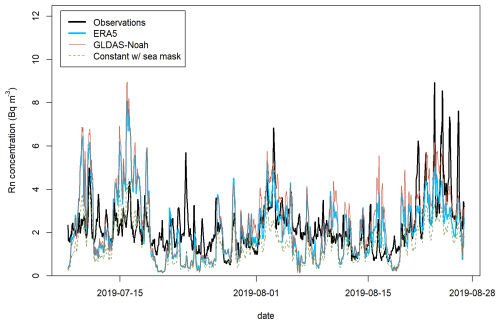
Figure 8DEC 222Rn concentrations – observations (black line) and modelled values using different radon exhalation maps: Flex-WRF-ERA5 (blue), Flex-WRF-GLDAS (red) and Flex-WRF-Const (dashed green).
A more detailed visual inspection of the simulated results seems to show that the model does not detect the remarkably high concentrations obtained during nocturnal peaks (accumulation phase), as seen in the periods of 29 March 2019 to 3 April 2019, 19 August 2019 to 27 August 2019 or 12 October 2019 to 29 October 2019 (Fig. S6). Looking at the average diurnal cycle for the whole 2019 dataset (Fig. 9) it can be noticed that observations and models peak at the same time (06:00 UTC), but the observed peak is much stronger than the simulated one, being 0.7 Bq m−3 higher than Flex-WRF-GLDAS and 0.9 Bq m−3 higher than Flex-WRF-ERA5. However, between 10:00 and 00:00 UTC the averaged radon concentrations are similar to the modelled ones, and the observed hourly average value remains between the Flex-WRF-GLDAS and the Flex-WRF-ERA5 hourly average values. The averaged modelled values using Flex-WRF-Const are much lower for all the diurnal cycle.
This bias between the observed and modelled radon concentrations at the daily peak was not constant over the tested year. For example, in April and May no bias was observed between radon observations and Flex-WRF-ERA5-modelled radon data. An average bias of 1.21 Bq m−3 was found in the months of October–November. This variability may also induce biases in the calculated nocturnal radon fluxes and therefore in the methane fluxes retrieved with the RTM. However, the variability in bias may not be solely attributed to the calculated radon fluxes but also to the WRF input, making it difficult to quantify. This could warrant further analysis.
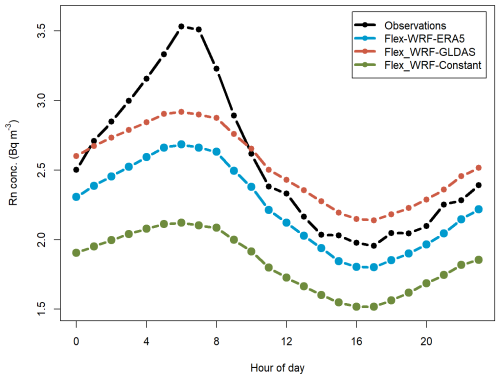
Figure 9Average diurnal cycle of 222Rn concentration at DEC – observations (black line) and modelled values using different radon exhalation maps: Flex-WRF-ERA5 (blue), Flex-WRF-GLDAS (red) and Flex-WRF-Constant (green).
It is known from the literature that the nocturnal boundary layer height (BLH) is one of the most challenging variables to simulate in mesoscale models (García-Díez et al., 2013), and this fact can cause a significant impact on transport model outputs (Díaz-Isaac et al., 2018; Gerbig et al., 2008; Mohan and Gupta, 2018). It has been proven in previous studies that the nocturnal boundary layer often gets overestimated or underestimated in dispersion models (Arnold et al., 2010; Williams et al., 2011) and that it can be the main cause of divergence between simulated and observed nocturnal atmospheric concentrations. However, overall differences between model and observations may be attributable to both radon flux maps and transport models, and from the data obtained it is not possible to attribute a higher contribution in the uncertainties to the radon maps or to the atmospheric models.
3.2.3 Nocturnal footprint of the station
At DEC station the inlet was located at 10 m a.g.l., and, therefore, it can be considered that the station footprint at night was very local. From the hourly footprints calculated with Flex-WRF for all nights where RTM was applied using the wind speed threshold of 1.5 m s−1, the influence area was calculated too. Figure 10 shows the normalized average residence time for all back trajectories from DEC during nights where the RTM was applied considering a 1.5 m h−1 threshold. Results show that the ERD represents ∼50 % of the influence area for the air sampled at the DEC station, while another 35 % is over the sea, and the rest (15 %) is a continental influence. Considering negligible radon and methane fluxes coming from the sea (Weber et al., 2019; Wilkening and Clements, 1975; Zahorowski et al., 2013), it may be considered that RTM-based CH4 fluxes will mainly be due to the ERD contribution except for a 15 % of continental influence. Taking into consideration that the models overestimate the nocturnal mixing (as seen in Fig. 9) and the nocturnal wind speed (as seen in Fig. 7), the continental contribution would probably be lower. In addition, Fig. 3 shows that methane emissions from this continental area, as presented by the EDGAR inventory, are less than 0.5 mg CH4 m−2 h−1. This represents only 10 % of the methane flux values reported for the station's closest grids.
3.2.4 Radon flux cycles
Annual cycles of radon flux were calculated considering four different integration levels: (i) DEC station (the darkest pixel as illustrated in Fig. 10), (ii) the whole ERD (red dotted line pixels as illustrated in Fig. 10), (iii) the 70 km × 70 km window surrounding DEC (complete area shown in Fig. 10) and (iv) the footprint-weighted radon flux applied for the RTM. As shown in Fig. 11a, a clear annual cycle was observed with maximum values in summer. However, it seems that radon exhalation models are not taking into account an agricultural practice characteristic of rice paddies: the flooding of the fields (Fig. 2) or, in other words, the existence of a water table of a certain level in rice crop fields that would decrease radon exhalation. Additionally, the increase in 222Rn concentration in winter months (in day and nighttime) (see Fig. 5) does not seem compatible with the modelled radon flux cycle.
The observed bias between observations and modelled radon concentrations for different periods of the year (2019) is shown in Fig. 11b, both for the whole day and only for the afternoon (15:00 to 18:00). Results show that both ERA5 and GLDAS radon exhalation maps are probably underestimating radon fluxes in autumn (October–November), while they seem to overestimate radon fluxes in May. A constant continental value of 15.8 mBq m−2 h−1 seems to be underestimated at least for summer and autumn months, as was already observed analysing the average diurnal cycle (Fig. 9). Therefore, the constant value 222Rn map will not be used to retrieve methane fluxes with RTM. Radon concentration bias in the afternoon does not differ from bias for the whole day.
Finally, the observed biases may indicate that the seasonality observed using radon exhalation maps may not agree with the real radon emission at ERD area. Although no bias data are available for December, high atmospheric radon concentration values in that month (see Sect. 3.1) indicate an increase in the radon flux for that month near DEC station, which is not observed based on radon exhalation maps. This increase could be driven by the complete drying of rice fields, which is not taken into consideration in the land models.
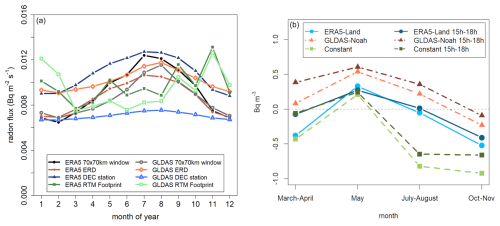
Figure 11(a) Average annual cycle of 222Rn exhalation values for the 70 km × 70 km window, ERD and DEC station grid, and RTM footprint-weighted for both ERA5 and GLDAS models. (b) Bias between observations and modelled radon concentrations for 2019 for the whole day and for the afternoon (15:00–18:00).
The footprint-weighted radon fluxes show a different trend than radon flux maps, which may be caused by the seasonality of winds, coming from the northwest in winter months. Overall, the RTM footprint-weighted radon fluxes are similar for both models and in the same order of magnitude as the 70 km × 70 km window or the ERD.
3.3 RTM-based CH4 fluxes at the DEC station.
Figure 12 presents the monthly median values of the nocturnal CH4 fluxes obtained using the RTM with two radon exhalation maps: ERA5 and GLDAS taking into consideration the whole dataset (left plot) and only nights where the average wind speed was below 1.5 m s−1 (right plot). A constant radon flux map was not used in this second part of the study, as previously explained (see Sect. 3.2.2).
The Shapiro–Wilk test for normality (Shapiro and Wilk, 1965) was performed for the RTM CH4 flux data, indicating that flux data were not following a normal distribution (w<0.29, p value <0.01) but that there were no reasons to reject a log-normal distribution (w=0.99, p value = 0.67). Therefore, monthly median CH4 flux values were used instead of monthly mean values. The RTM selection criteria used in this study restricted the percentage of nocturnal accumulation events used over the 7-year (2013–2019) dataset to its 15 % when using the whole dataset and to 7 % when using only nights with average wind speed below 1.5 m s−1. Table 2 shows, for each month, the percentage of nights that were selected over the total available, the median and the standard deviation of the log-normal distribution () of the retrieved RTM-based CH4 fluxes using the two radon exhalation maps. Table 3 shows the same values when using only events with an average wind speed below 1.5 m s−1.
Table 3Statistics of the RTM application at the DEC station for the 2013–2019 period considering only nights with average wind speed <1.5 m s−1.
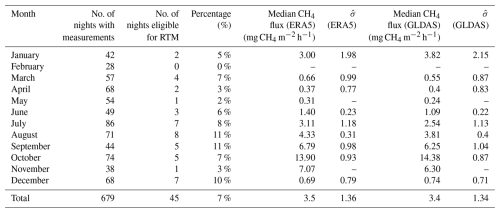
Although some differences are observed when using only night events when the wind is lower than 1.5 m s−1 compared to when no wind restriction is used, the methane fluxes follow the same seasonal pattern. In October, the month with the largest estimated emissions, flux values are exactly the same. The largest discrepancies are found in September, when methane fluxes with wind restrictions are more than double the methane fluxes measured with no wind restrictions. The average annual fluxes are 15 % higher when only the events with a wind speed under 1.5 m s−1 are selected.
The number of eligible events with wind restrictions is less than half of the nights when no wind restrictions are used. Therefore, the representativeness decreases, and in February, for example, no events are available as eligible for RTM. Thus, and given the small differences using or not using the wind speed threshold value, the values obtained considering no wind restriction will be used for the comparison of the annual emissions with other studies and inventories.
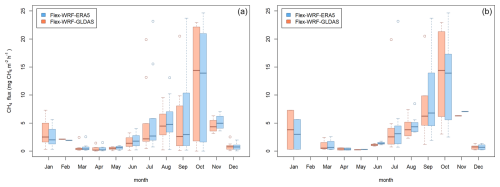
Figure 12Box plots of the RTM-based methane fluxes over the DEC station calculated using Flex-WRF-ERA5 (blue) and Flex-WRF-GLDAS (red) for every month of the year (period 2013–2019) for the whole dataset (a) and only taking into consideration events with an average wind speed (ws) <1.5 m s−1 (b). Outliers are represented with circles, boxes represent the region between interquartiles Q1 and Q3, and horizontal solid lines represent the medians.
The average difference between RTM-based CH4 fluxes obtained using Flex-WRF-ERA5 and Flex-WRF-GLDAS models was only 0.1±0.2 mg CH4 m−2 h−1. This difference remains the same regardless of whether the wind threshold is applied. The monthly RTM-based methane fluxes obtained with Flex-WRF-ERA5 (and Flex-WRF-GLDAS) showed a strong seasonality, with a maximum in October with a median flux of 13.9 (14.4) mg CH4 m−2 h−1 and a minimum between the months of March, April and May, with values between 0.2 and 0.7 (0.2 and 0.6) mg CH4 m−2 h−1. For the data without a wind threshold, the average methane flux for the period between tillering and straw incorporation (i.e. between June and November) was 5.2 (4.9) mg CH4 m−2 h−1. For the period when the fields were dried (i.e. February to April), the average methane flux decreased to 0.8 (0.9) mg CH4 m−2 h−1. Finally, the total annual average emission rate was calculated to be 3.1 (3.0) mg CH4 m−2 h−1. This emission is equivalent to an annual emission of 262.8 kg CH4 ha−1.
Based on radon concentration simulation results, it was not possible to determine which of the two radon flux maps performed better, as results varied for the different periods of the year and showed a consistent trend between both. In addition, no previous studies are available in the literature evaluating these two radon flux maps. Therefore, for the calculation of methane fluxes with RTM, both maps have to be considered. However, differences in flux measurements are low (<5 %), and, therefore, we will refer only to the results obtained with ERA5 radon exhalation map for the comparison with other studies.
3.4 RTM-based CH4 fluxes vs. CH4 fluxes from the literature
Average 2013–2019 methane fluxes from the EDGAR v7.0 inventory are shown in Fig. 3. Although EDGAR v7.0 counts for agriculture soils emissions, its data do not consider the emissions from rice paddy fields at ERD, as the emissions from agricultural soils assigned in the pixels of the ERD are below 0.02 mg CH4 m−2 h−1. The 80 % of the emission assigned at the pixel of DEC station is related to a cow farm located 9 km west from the station. The largest emissions in the area are located 55 km northeast of the sampling site and are related to a petrochemical industry complex. From this dataset, it may be confirmed that no accounted significant anthropogenic methane emissions are present in the area around the station apart from the unaccounted methane due to ERD rice fields. The fact that from January to June no methane diurnal cycles are observed at DEC supports the hypothesis that the methane fluxes observed can be entirely attributed to the local rice fields. Moreover, assuming zero emissions of methane and radon from the sea, it can be inferred that when wind is coming from the sea all the signal in RTM is coming from the ERD. Therefore, taking into consideration the footprint area, RTM results can be considered a good proxy of the variability of methane emissions due to rice cultivation cycle in ERD over the months of the year.
Monthly methane flux values obtained by Martínez-Eixarch et al. (2018) at ERD with static chambers are plotted together with RTM-based results from the present work in Fig. 13. The plot shows a remarkable correlation between both results, obtained using independent methodologies. The seasonal variability of the flux estimated using both methodologies follows a consistent pattern during productive and fallout months. However, December stands out as the month with the greatest disagreement between the two methodologies, with the RTM estimation being 2 mg CH4 m−2 h−1 lower than the static chamber estimation. This disparity could be caused by an underestimation of the radon fluxes in December, as seen in Sect. 3.2.4. The absolute values are similar during months with the highest emissions. For instance, in October RTM-based results estimated a median flux of 13.9 mg CH4 m−2 h−1, while the fluxes from static chambers were calculated as 14.7±4.2 mg CH4 m−2 h−1.
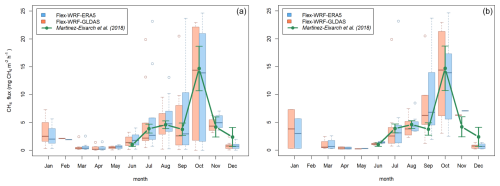
Figure 13Box plots of the RTM-based methane fluxes over the DEC station calculated using Flex-WRF-ERA5 (blue) and Flex-WRF-GLDAS (red) for every month of the year (period 2013–2019) for the whole dataset (a) and only taking events with wind speed <1.5 m s−1 into consideration(b) and methane fluxes over ERD using static chambers (green points and lines) (Martínez-Eixarch et al., 2018).
In a study conducted by Wang et al. (2018), global modelling of rice fields emissions was undertaken, accounting for multiple parameters at each country. The country-specific emission factor for Spain was estimated to be 1.13 kg CH4 h−1 d−1. In the Ebro Delta, the emission factor according to the latest national inventory of Spain reported to the UNFCC (National Inventory Report of Spain, 2023), is 1.32 kg CH4 h−1 d−1. This inventory emission corresponds to an emission of 5.54 mg CH4 m−2 h−1 during the crop period and a total yearly emission of 198.5 kg CH4 ha−1 using the inventoried rice crop period of 150 d reported to the UNFCC. With the RTM methodology the estimated annual emission was 262.8 kg CH4 ha−1. In the work by Martínez-Eixarch et al. (2018), the annual emission is reported to be 262.6 kg CH4 ha−1. The outstanding similarity using both methodologies, however, has to be taken carefully due to the high uncertainty of both methods, but it confirms the suitability of both methodologies for the calculation of methane fluxes in a region as the ERD.
RTM-based CH4 flux estimations show that emissions were distributed throughout the year and that the higher ones corresponded to the months of harvest and straw management. However, during all months that the fields were flooded, emissions were significantly higher than those inventoried in EDGAR and only similar to the inventories in months where the fields are dried (March–April). As in the work by Martínez-Eixarch et al. (2018), it can be seen that neglecting the fallow season can significantly underestimate annual emissions. Methane emissions from October to December account for 54 % of the total, while emissions during the growing period (May–September) represent only 31 %. Finally, emissions from January to April make up just 15 % of the total methane emissions.
3.5 Uncertainty and representativeness of the RTM-based CH4 fluxes at DEC
One of the simplifications considered for the application of the RTM is that fluxes should be homogeneous around the station, as strong point sources could affect the concentrations measured at the station and the regional flux estimation. Although the ERD is relatively small compared to other areas where the RTM has been applied (Schmidt et al., 1996; Levin et al., 2021), the short height of the sampling tower and the homogeneity of the ERD make this area well-suited for the application of the RTM.
The difficulty of the application of the RTM in this study is sure, but the evaluation of both meteorological and atmospheric transport models for the area and periods of interest and the comparison of the RTM-based methane fluxes results with national inventories and other independent experimental studies from the bibliography add useful highlights for the research in this field and improvement of the RTM application protocols.
As seen in Sect. 3.2, the WRF model in regions like ERD does not always simulate the nocturnal accumulation and the wind speeds correctly, deriving significant bias in concentration simulations. The advantage of the work exposed here is that due to the short height of the sampling point, the footprint of the station is quite small, within a few kilometres, and thus, the footprint is more reliable. Moreover, by applying the 1.5 m s−1 wind speed threshold for selecting RTM-feasible night events, we ensure minimal advection from continental sources. In agreement with EDGAR emission inventories, the CORINE Land Cover map, and other bibliographic studies, there are no significant contributions to the methane emissions compared to those from rice paddies. Methane fluxes over the footprint area and when rice paddies are dried are between 0.3 and 0.6 mg CH4 m−2 h−1, while our results, corroborated by the literature (Martínez-Eixarch et al., 2018) and other studies in rice fields (Wang et al., 2018), show methane fluxes due to the rice fields above 3 mg CH4 m−2 h−1 between July and November. Considering these differences, the external contribution to the rice paddies methane emissions may be assumed with an uncertainty between 10 %–15 %.
One of the elements that produces more uncertainty in the calculus of the methane flux using the RTM is the uncertainty of real radon flux distribution over the footprint area of the measurement station (Vogel et al., 2012; Levin et al., 2021). In Eq. (3), the radon flux is directly proportional to the estimated methane flux. Therefore, an error in the radon flux will proportionally produce an error in the estimated methane flux. For this reason, until the radon flux maps in the area over the DEC station could be sufficiently validated, the global annual methane flux estimated with the RTM should be carefully accepted assuming a certain uncertainty. On the other hand, the integration, in this work, of data from several years, makes the result more robust than if using data from a single year.
One of the limitations of the RTM is that only the nocturnal emissions are monitored. In the case of rice fields, it is well known that the gross ecosystem photosynthesis (GEP) and the soil temperature are drivers of CH4 flux variability (Hatala et al., 2012). Although diel fluxes and nocturnal fluxes keep a strong correlation (Wassmann et al., 2018), methane emissions in the early afternoon can be between 10 % and 20 % higher than the nocturnal emissions during the productive months (Alberto et al., 2014; Dai et al., 2019; Minamikawa et al., 2012). This difference may lead to an underestimation, ranging between 10 % (Weller et al., 2015) and 20 % (Wassmann et al., 2018), of diel fluxes if considering only the nocturnal emissions.
Using currently available radon flux maps, the meteorological model WRF, modelled particle back trajectories with the atmospheric transport model FLEXPART, and methane and radon atmospheric concentration observations from a 10 m a.g.l. tower, the methane flux variability over the rice crop area of the ERD, in the northeast of the Iberian Peninsula, was evaluated. Prior to this calculation, modelled back trajectories and the different radon exhalation maps used in the study were evaluated by simulating radon concentrations at the tower sampling point and comparing them with observations. The two main conclusions drawn from this previous comparison are as follows:
-
Atmospheric transport models are not yet able to accurately estimate the nocturnal boundary layer in coastal areas such as the ERD, often overestimating the vertical mixing.
-
The seasonality observed in the radon exhalation maps from Karstens and Levin (2023) may not be adequately parametrized in the ERD area, as different bias among the months is observed between the modelled and observed atmospheric radon concentration, mainly during peak events. Although the biases could also be produced by the seasonal difference in the transport model performance, the estimated radon fluxes at DEC do not seem to take into consideration the seasonality of the water table height within this area.
From the application of the RTM, a strong annual cycle of methane emissions is observed. This annual cycle is related with the rice crop cycle, with the highest emissions in October coinciding with harvest and straw incorporation into the fields. When a wind threshold of 1.5 m s−1 is used for RTM application, minor differences are observed. The overall pattern is the same with an increase of 15 % in average annual emissions. The methane emission pattern and values are remarkably similar to a study done with static chambers for 2 years, by other authors, which can be useful to validate the presented methodology. The total annual methane emissions estimated are 262.8 kg CH4 ha−1, close to the 262.6 kg CH4 ha−1 from the study of the static chambers and 32 % higher than the UNFCC inventoried value (198.5 kg CH4 ha−1). The independent EDGAR emissions database does not account for methane emissions from this rice field area.
Absolute emission values given by the RTM should be handled with care, as there are many assumptions and simplifications considered. However, its application has been proven to be incredibly useful to know the inter-annual variability of regional methane emissions (Levin et al., 2021); to amend inventory values for not considering seasonality of livestock management (Grossi et al., 2018); or, as in this work, to understand and quantify the seasonal variability of emissions over a reduced area and its relation with the different phases of agricultural processes such as the rice cultivation.
Due to the hostile environmental conditions at the DEC station (extremely high humidity, elevated temperatures and salty air) the dataset presents several gaps. Thus, a year-to-year variability study was not feasible. Longer datasets in the future may be used with the RTM to monitor the inter-annual variability in methane emissions, which could be influenced by changes in agricultural management (e.g. straw management, water management or fertilization changes), without requiring resource-intensive extended static chamber campaigns. Considering the resources needed, an atmospheric station equipped with radon and methane instrumentation could be significantly more efficient than performing periodic surveys using accumulation chambers across the entire area of interest over an extended period.
Table A1 shows the main parameters used in the WRF modelling for radon simulation during 2019, as well as for the RTM footprint spanning the period from 2013 to 2019.
Flex-WRF was parametrized to be used with mean winds from WRF output and with convection, turbulence and PBL schemes.
As for the domains, while in WRF a Lambert conformal conic projection was used for a better performance, a regular lat–long grid was used in Flex-WRF for an easiest merge with radon maps, which are in regular lat–long grid projection.
Figure A1 shows the limits of the three domains for WRF simulations and the two domains for Flex-WRF back trajectories.
The data and codes for this paper are available from the CORA Repositori de Dades de Recerca at https://doi.org/10.34810/data1332 (Curcoll, 2024).
The supplement related to this article is available online at https://doi.org/10.5194/acp-25-6299-2025-supplement.
JAM, as PI of the ClimaDat project, designed and leaded the creation of the ClimaDat network. AÀ, SB, CG, LC, JAM and RC participated actively in the mounting and maintenance of the DEC station atmospheric measurements and drying system. RC and CG were in charge of the Picarro and AMON instruments and data production, respectively. CG designed the RTM application study for the DEC station. RC led this work, performed the Flex-WRF simulations needed for the RTM applications and for the model evaluation, and wrote the original draft of the manuscript. AV and CG coordinated the data analysis and discussions. AÀ, CG and AV contributed actively to the manuscript writing. All authors participated in the manuscript writing and agreed to the published version of the paper.
The contact author has declared that none of the authors has any competing interests.
Publisher's note: Copernicus Publications remains neutral with regard to jurisdictional claims made in the text, published maps, institutional affiliations, or any other geographical representation in this paper. While Copernicus Publications makes every effort to include appropriate place names, the final responsibility lies with the authors.
Alba Àgueda is a Serra Hunter Fellow. The authors would like to thank the members of the ClimaDat project, who worked for the maintenance of the ClimaDat DEC station: Manel Nofuentes, Eusebi Vàzquez, Òscar Batet and Paola Occhipinti. The authors would also like to acknowledge the workers of the “Estació biològica del Canal Vell”, particularly Miquel Àngel Franch and Laura Fortuño, for their help and cooperation. Finally, this work is dedicated to the beloved memory of our ClimaDat colleague Òscar Batet Torrell.
All the measurements at the DEC station were supported by the ClimaDat project (Obra Social “La Caixa”, 2010–2019). Part of the research was carried out under the project “Methane interchange between soil and air over the Iberian Peninsula” (grant no. CGL2013-46186-R), funded by the Ministerio Español de Economía y Competitividad. The modelling, data analysis, application of the RTM and manuscript writing was carried out under the 19ENV01 traceRadon project, which has received funding from the EMPIR programme co-financed by the Participating States and from the European Union's Horizon 2020 Research and Innovation programme.
This paper was edited by Chris Wilson and reviewed by Fabian Maier, Dafina Kikaj, and one anonymous referee.
Àgueda, A., Grossi, C., Pastor, E., Rioja, E., Sánchez-García, L., Batet, Ò., Curcoll, R., Ealo, M., Nofuentes, M., Occhipinti, P., Rodó, X., and Morguí, J.-A.: Temporal and spatial variability of ground level atmospheric methane concentrations in the Ebro River Delta, Atmos. Pollut. Res., 8, 741–753, https://doi.org/10.1016/j.apr.2017.01.009, 2017.
Ahmadov, R., Gerbig, C., Kretschmer, R., Körner, S., Rödenbeck, C., Bousquet, P., and Ramonet, M.: Comparing high resolution WRF-VPRM simulations and two global CO2 transport models with coastal tower measurements of CO2, Biogeosciences, 6, 807–817, https://doi.org/10.5194/bg-6-807-2009, 2009.
Alberto, M. C. R., Wassmann, R., Buresh, R. J., Quilty, J. R., Correa, T. Q., Sandro, J. M., and Centeno, C. A. R.: Measuring methane flux from irrigated rice fields by eddy covariance method using open-path gas analyzer, F. Crop. Res., 160, 12–21, https://doi.org/10.1016/j.fcr.2014.02.008, 2014.
Alberto, M. C. R., Wassmann, R., Gummert, M., Buresh, R. J., Quilty, J. R., Correa, T. Q., Centeno, C. A. R., and Oca, G. M.: Straw incorporated after mechanized harvesting of irrigated rice affects net emissions of CH4 and CO2 based on eddy covariance measurements, F. Crop. Res., 184, 162–175, https://doi.org/10.1016/j.fcr.2015.10.004, 2015.
Aliaga, D., Sinclair, V. A., Andrade, M., Artaxo, P., Carbone, S., Kadantsev, E., Laj, P., Wiedensohler, A., Krejci, R., and Bianchi, F.: Identifying source regions of air masses sampled at the tropical high-altitude site of Chacaltaya using WRF-FLEXPART and cluster analysis, Atmos. Chem. Phys., 21, 16453–16477, https://doi.org/10.5194/acp-21-16453-2021, 2021.
Alvarado-Aguilar, D., Jiménez, J. A., and Nicholls, R. J.: Flood hazard and damage assessment in the Ebro Delta (NW Mediterranean) to relative sea level rise, Nat. Hazards, 62, 1301–1321, https://doi.org/10.1007/s11069-012-0149-x, 2012.
Arnold, D.: Study of the atmospheric radon concentration dynamics at the Spanish readiological surveillance stations and its application to air mass movements, Ph.D. Thesis, Universitat Politècnica de Catalunya (UPC), 2009.
Arnold, D., Vargas, A., Vermeulen, A. T., Verheggen, B., and Seibert, P.: Analysis of radon origin by backward atmospheric transport modelling, Atmos. Environ., 44, 494–502, https://doi.org/10.1016/j.atmosenv.2009.11.003, 2010.
Beaudoing, H. and M. Rodell, NASA/GSFC/HSL [data set]. GLDAS Noah Land Surface Model L4 3 hourly 0.25×0.25 degree V2.1, Goddard Earth Sciences Data and Information Services Center (GES DISC), https://doi.org/10.5067/E7TYRXPJKWOQ, 2020.
Belenguer-Manzanedo, M., Alcaraz, C., Camacho, A., Ibáñez, C., Català-Forner, M., and Martínez-Eixarch, M.: Effect of post-harvest practices on greenhouse gas emissions in rice paddies: flooding regime and straw management, Plant Soil, 474, 77–98, https://doi.org/10.1007/s11104-021-05234-y, 2022.
Biraud, S., Ciais, P., Ramonet, M., Simmonds, P., Kazan, V., Monfray, P., O'Doherty, S., Spain, T. G., and Jennings, S. G.: European greenhouse gas emissions estimated from continuous atmospheric measurements and radon 222 at Mace Head, Ireland, J. Geophys. Res.-Atmos., 105, 1351–1366, https://doi.org/10.1029/1999JD900821, 2000.
Brioude, J., Arnold, D., Stohl, A., Cassiani, M., Morton, D., Seibert, P., Angevine, W., Evan, S., Dingwell, A., Fast, J. D., Easter, R. C., Pisso, I., Burkhart, J., and Wotawa, G.: The Lagrangian particle dispersion model FLEXPART-WRF version 3.1, Geosci. Model Dev., 6, 1889–1904, https://doi.org/10.5194/gmd-6-1889-2013, 2013.
Casanova, D.: Quantifying the effects of land conditions on rice growth: a case study in the Ebro Delta (Spain) using remote sensing, Ph.D. thesis, Wageningen Agricultural University, ISBN 90-5485-867-2, 1998.
Cerralbo, P., Grifoll, M., Moré, J., Bravo, M., Sairouní Afif, A., and Espino, M.: Wind variability in a coastal area (Alfacs Bay, Ebro River delta), Adv. Sci. Res., 12, 11–21, https://doi.org/10.5194/asr-12-11-2015, 2015.
Cheewaphongphan, P., Chatani, S., and Saigusa, N.: Exploring Gaps between Bottom-Up and Top-Down Emission Estimates Based on Uncertainties in Multiple Emission Inventories: A Case Study on CH4 Emissions in China, Sustainability, 11, 2054, https://doi.org/10.3390/su11072054, 2019.
Chen, Z., Jacob, D. J., Nesser, H., Sulprizio, M. P., Lorente, A., Varon, D. J., Lu, X., Shen, L., Qu, Z., Penn, E., and Yu, X.: Methane emissions from China: a high-resolution inversion of TROPOMI satellite observations, Atmos. Chem. Phys., 22, 10809–10826, https://doi.org/10.5194/acp-22-10809-2022, 2022.
Cinelli, G., Tollefsen, T., Bossew, P., Gruber, V., Bogucarskis, K., De Felice, L., and De Cort, M.: Digital version of the European Atlas of natural radiation, J. Environ. Radioact., 196, 240–252, https://doi.org/10.1016/j.jenvrad.2018.02.008, 2019.
Crosson, E. R.: A cavity ring-down analyzer for measuring atmospheric levels of methane, carbon dioxide, and water vapor, Appl. Phys. B, 92, 403–408, https://doi.org/10.1007/s00340-008-3135-y, 2008.
Curcoll, R., Grossi, C., Röttger, S., and Vargas, A.: Full characterization and calibration of a transfer standard monitor for atmospheric radon measurements, Atmos. Meas. Tech., 17, 3047–3065, https://doi.org/10.5194/amt-17-3047-2024, 2024.
Curcoll, R.: Replication Data for: Estimation of seasonal methane fluxes over a Mediterranean rice paddy area using the Radon Tracer Method (RTM), CORA.Repositori de Dades de Recerca, V1 [code and data set], https://doi.org/10.34810/data1332, 2024.
Dai, S., Ju, W., Zhang, Y., He, Q., Song, L., and Li, J.: Variations and drivers of methane fluxes from a rice-wheat rotation agroecosystem in eastern China at seasonal and diurnal scales, Sci. Total Environ., 690, 973–990, https://doi.org/10.1016/j.scitotenv.2019.07.012, 2019.
Desjardins, R. L., Worth, D. E., Pattey, E., VanderZaag, A., Srinivasan, R., Mauder, M., Worthy, D., Sweeney, C., and Metzger, S.: The challenge of reconciling bottom-up agricultural methane emissions inventories with top-down measurements, Agric. For. Meteorol., 248, 48–59, https://doi.org/10.1016/j.agrformet.2017.09.003, 2018.
Díaz-Isaac, L. I., Lauvaux, T., and Davis, K. J.: Impact of physical parameterizations and initial conditions on simulated atmospheric transport and CO2 mole fractions in the US Midwest, Atmos. Chem. Phys., 18, 14813–14835, https://doi.org/10.5194/acp-18-14813-2018, 2018.
Dlugokencky, E. J.: Conversion of NOAA atmospheric dry air CH4 mole fractions to a gravimetrically prepared standard scale, J. Geophys. Res., 110, D18306, https://doi.org/10.1029/2005JD006035, 2005.
Drinkwater, A., Palmer, P. I., Feng, L., Arnold, T., Lan, X., Michel, S. E., Parker, R., and Boesch, H.: Atmospheric data support a multi-decadal shift in the global methane budget towards natural tropical emissions, Atmos. Chem. Phys., 23, 8429–8452, https://doi.org/10.5194/acp-23-8429-2023, 2023.
Eggleston, H. S., Buendia, L., Miwa, K., Ngara, T., and Tanabe, K.: IPCC Guidelines for National Greenhouse Gas Inventories, Intergovernmental Panel on Climate Change, ISBN 4-88788-032-4, 2006.
European Commission: EDGAR (Emissions Database for Global Atmospheric Research) Community GHG Database, https://edgar.jrc.ec.europa.eu/report_2023 (last access: 27 November 2023), 2023.
European Union: Copernicus Land Monitoring Service 2018, European Environment Agency (EEA), https://doi.org/10.2909/960998c1-1870-4e82-8051-6485205ebbac, 2018.
Fitzgerald, G. J., Scow, K. M., and Hill, J. E.: Fallow season straw and water management effects on methane emissions in California rice, Global Biogeochem. Cycles, 14, 767–776, https://doi.org/10.1029/2000GB001259, 2000.
Gangoiti, G., Alonso, L., Navazo, M., Albizuri, A., Perez-Landa, G., Matabuena, M., Valdenebro, V., Maruri, M., Antonio García, J., and Millán, M. M.: Regional transport of pollutants over the Bay of Biscay: Analysis of an ozone episode under a blocking anticyclone in west-central Europe, Atmos. Environ., 36, 1349–1361, https://doi.org/10.1016/S1352-2310(01)00536-2, 2002.
García-Díez, M., Fernández, J., Fita, L., and Yagüe, C.: Seasonal dependence of WRF model biases and sensitivity to PBL schemes over Europe, Q. J. Roy. Meteor. Soc., 139, 501–514, https://doi.org/10.1002/qj.1976, 2013.
Generalitat de Catalunya: Plec de condicions de la denominació d'origen protegida “Arròs del Delta de l'Ebre”, http://agricultura.gencat.cat/web/.content/al_alimentacio/al02_qualitat_alimentaria/al02_04_dop/documents/fitxers_estatics/pliego_condiciones_inf_pub_castellano_dop_arroz_delta_ebro.pdf (last access: 23 March 2025), 2022.
Gerbig, C., Körner, S., and Lin, J. C.: Vertical mixing in atmospheric tracer transport models: error characterization and propagation, Atmos. Chem. Phys., 8, 591–602, https://doi.org/10.5194/acp-8-591-2008, 2008.
Griffiths, A. D., Parkes, S. D., Chambers, S. D., McCabe, M. F., and Williams, A. G.: Improved mixing height monitoring through a combination of lidar and radon measurements, Atmos. Meas. Tech., 6, 207–218, https://doi.org/10.5194/amt-6-207-2013, 2013.
Grossi, C., Arnold, D., Adame, J. A., López-Coto, I., Bolívar, J. P., De La Morena, B. A., and Vargas, A.: Atmospheric 222Rn concentration and source term at El Arenosillo 100 m meteorological tower in southwest Spain, Radiat. Meas., 47, 149–162, https://doi.org/10.1016/j.radmeas.2011.11.006, 2012.
Grossi, C., Àgueda, A., Vogel, F. R., Vargas, A., Zimnoch, M., Wach, P., Martín, J. E., López-Coto, I., Bolívar, J. P., Morguí, J. A., and Rodó, X.: Analysis of ground-based 222Rn measurements over Spain: Filling the gap in southwestern Europe, J. Geophys. Res.-Atmos., 121, 11021–11037, https://doi.org/10.1002/2016JD025196, 2016.
Grossi, C., Vogel, F. R., Curcoll, R., Àgueda, A., Vargas, A., Rodó, X., and Morguí, J.-A.: Study of the daily and seasonal atmospheric CH4 mixing ratio variability in a rural Spanish region using 222Rn tracer, Atmos. Chem. Phys., 18, 5847–5860, https://doi.org/10.5194/acp-18-5847-2018, 2018.
Grossi, C., Chambers, S. D., Llido, O., Vogel, F. R., Kazan, V., Capuana, A., Werczynski, S., Curcoll, R., Delmotte, M., Vargas, A., Morguí, J.-A., Levin, I., and Ramonet, M.: Intercomparison study of atmospheric 222Rn and 222Rn progeny monitors, Atmos. Meas. Tech., 13, 2241–2255, https://doi.org/10.5194/amt-13-2241-2020, 2020.
Hall, B. D., Crotwell, A. M., Kitzis, D. R., Mefford, T., Miller, B. R., Schibig, M. F., and Tans, P. P.: Revision of the World Meteorological Organization Global Atmosphere Watch (WMO/GAW) CO2 calibration scale, Atmos. Meas. Tech., 14, 3015–3032, https://doi.org/10.5194/amt-14-3015-2021, 2021.
Hatala, J. A., Detto, M., and Baldocchi, D. D.: Gross ecosystem photosynthesis causes a diurnal pattern in methane emission from rice, Geophys. Res. Lett., 39, 1–5, https://doi.org/10.1029/2012GL051303, 2012.
Hegarty, J., Draxler, R. R., Stein, A. F., Brioude, J., Mountain, M., Eluszkiewicz, J., Nehrkorn, T., Ngan, F., Andrews, A., Division, C. S., and Division, G. M.: Evaluation of lagrangian particle dispersion models with measurements from controlled tracer releases, J. Appl. Meteorol. Climatol., 52, 2623–2637, https://doi.org/10.1175/JAMC-D-13-0125.1, 2013.
Hersbach, H., Bell, B., Berrisford, P., Hirahara, S., Horányi, A., Muñoz-Sabater, J., Nicolas, J., Peubey, C., Radu, R., Schepers, D., Simmons, A., Soci, C., Abdalla, S., Abellan, X., Balsamo, G., Bechtold, P., Biavati, G., Bidlot, J., Bonavita, M., De Chiara, G., Dahlgren, P., Dee, D., Diamantakis, M., Dragani, R., Flemming, J., Forbes, R., Fuentes, M., Geer, A., Haimberger, L., Healy, S., Hogan, R. J., Hólm, E., Janisková, M., Keeley, S., Laloyaux, P., Lopez, P., Lupu, C., Radnoti, G., de Rosnay, P., Rozum, I., Vamborg, F., Villaume, S., and Thépaut, J. N.: The ERA5 global reanalysis, Q. J. Roy. Meteor. Soc., 146, 1999–2049, https://doi.org/10.1002/qj.3803, 2020.
Hiederer, R.: Mapping soil properties for Europe – spatial representation of soil database attributes, (No. EUR26082EN), Sci. Tech. Res. Ser., 47, 1831–9424, 2013.
Hüser, I., Harder, H., Heil, A., and Kaiser, J. W.: Assumptions about footprint layer heights influence the quantification of emission sources: a case study for Cyprus, Atmos. Chem. Phys., 17, 10955–10967, https://doi.org/10.5194/acp-17-10955-2017, 2017.
Iwata, H., Mano, M., Ono, K., Tokida, T., Kawazoe, T., Kosugi, Y., Sakabe, A., Takahashi, K., and Miyata, A.: Exploring sub-daily to seasonal variations in methane exchange in a single-crop rice paddy in central Japan, Atmos. Environ., 179, 156–165, https://doi.org/10.1016/j.atmosenv.2018.02.015, 2018.
Karstens, U. and Levin, I.: traceRadon monthly radon flux map for Europe 2006-2022 (based on GLDAS-Noah v2.1 soil moisture), https://hdl.handle.net/11676/YLHSb9HhpYbqzMpd4yPmfm3s (last access: 23 March 2025), 2023.
Karstens, U., Schwingshackl, C., Schmithüsen, D., and Levin, I.: A process-based 222radon flux map for Europe and its comparison to long-term observations, Atmos. Chem. Phys., 15, 12845–12865, https://doi.org/10.5194/acp-15-12845-2015, 2015.
Lan, X., Thoning, K. W., Dlugockencky, E. J., Lan, X., Thoning, K. W., Dlugokencky, E. J., Lan, X., Thoning, K. W., and Dlugockencky, E. J.: Trends in globally-averaged CH4, N2O, and SF6 determined from NOAA Global Monitoring Laboratory measurements, Global Monitoring Laboratory, https://doi.org/10.15138/P8XG-AA10, 2024.
Levin, I., Glatzel-Mattheier, H., Marik, T., Cuntz, M., Schmidt, M., and Worthy, D. E.: Verification of German methane emission inventories and their recent changes based on atmospheric observations, J. Geophys. Res.-Atmos., 104, 3447–3456, https://doi.org/10.1029/1998JD100064, 1999.
Levin, I., Hammer, S., Eichelmann, E., and Vogel, F. R.: Verification of greenhouse gas emission reductions: the prospect of atmospheric monitoring in polluted areas, Philos. T. Roy. Soc. A, 369, 1906–1924, https://doi.org/10.1098/rsta.2010.0249, 2011.
Levin, I., Karstens, U., Hammer, S., DellaColetta, J., Maier, F., and Gachkivskyi, M.: Limitations of the radon tracer method (RTM) to estimate regional greenhouse gas (GHG) emissions – a case study for methane in Heidelberg, Atmos. Chem. Phys., 21, 17907–17926, https://doi.org/10.5194/acp-21-17907-2021, 2021.
Madala, S., Hari Prasad, K. B. R. R., Srinivas, C. V., and Satyanarayana, A. N. V.: Air quality simulation of NOx over the tropical coastal city Chennai in southern India with FLEXPART-WRF, Atmos. Environ., 128, 65–81, https://doi.org/10.1016/j.atmosenv.2015.12.052, 2016.
Martín, M., Plaza, J., Andrés, M. D., Bezares, J. C., and Millán, M. M.: Comparative study of seasonal air pollutant behavior in a Mediterranean coastal site: Castellón (Spain), Atmos. Environ. A, 25, 1523–1535, https://doi.org/10.1016/0960-1686(91)90012-V, 1991.
Martínez-Eixarch, M., Alcaraz, C., Viñas, M., Noguerol, J., Aranda, X., Prenafeta-Boldu, F. X., Saldaña-De la Vega, J. A., del Mar Catala, M., and Ibáñez, C.: Neglecting the fallow season can significantly underestimate annual methane emissions in Mediterranean rice fields, PLoS One, 13, e0198081, https://doi.org/10.1371/journal.pone.0198081, 2018.
Martínez-Eixarch, M., Alcaraz, C., Viñas, M., Noguerol, J., Aranda, X., Prenafeta-Boldú, F. X., Català-Forner, M., Fennessy, M. S., and Ibáñez, C.: The main drivers of methane emissions differ in the growing and flooded fallow seasons in Mediterranean rice fields, Plant Soil, 460, 211–227, https://doi.org/10.1007/s11104-020-04809-5, 2021.
Meijide, A., Manca, G., Goded, I., Magliulo, V., di Tommasi, P., Seufert, G., and Cescatti, A.: Seasonal trends and environmental controls of methane emissions in a rice paddy field in Northern Italy, Biogeosciences, 8, 3809–3821, https://doi.org/10.5194/bg-8-3809-2011, 2011.
Minamikawa, K., Yagi, K., Tokida, T., Sander, B. O., and Wassmann, R.: Appropriate frequency and time of day to measure methane emissions from an irrigated rice paddy in Japan using the manual closed chamber method, Greenh. Gas Meas. Manag., 2, 118–128, https://doi.org/10.1080/20430779.2012.729988, 2012.
Mohan, M. and Gupta, M.: Sensitivity of PBL parameterizations on PM10 and ozone simulation using chemical transport model WRF-Chem over a sub-tropical urban airshed in India, Atmos. Environ., 185, 53–63, https://doi.org/10.1016/j.atmosenv.2018.04.054, 2018.
Morgui, J. A., Agueda, A., Batet, O., Curcoll, R., Ealo, M., and Grossi, C.: ClimaDat: A long-term network to study at different scales climatic processes and interactions between climatic compartments, EGU General Assembly 2013, held 7–12 April 2013 in Vienna, Austria, id. EGU2013-10265, EGU Gen. Assem. Conf. Abstr., 15, https://ui.adsabs.harvard.edu/abs/2013EGUGA..1510265M (last access: 23 March 2025), 2013.
Muñoz Sabater, J.: ERA5-Land hourly data from 1950 to present. Copernicus Climate Change Service (C3S) Climate Data Store (CDS) [data set], https://doi.org/10.24381/cds.e2161bac, 2019.
National Inventory Report of Spain: National Inventory of Emissions of Greenhous Gases 1990–2015, https://unfccc.int/documents/627815 (last access: 21 November 2017), 2023.
Nazaroff, W. W.: Radon transport from soil to air, Rev. Geophys., 30, 137, https://doi.org/10.1029/92RG00055, 1992.
Oo, A. Z., Win, K. T., and Bellingrath-Kimura, S. D.: Within field spatial variation in methane emissions from lowland rice in Myanmar, Springerplus, 4, 145, https://doi.org/10.1186/s40064-015-0901-2, 2015.
Peischl, J., Ryerson, T. B., Holloway, J. S., Trainer, M., Andrews, A. E., Atlas, E. L., Blake, D. R., Daube, B. C., Dlugokencky, E. J., Fischer, M. L., Goldstein, A. H., Guha, A., Karl, T., Kofler, J., Kosciuch, E., Misztal, P. K., Perring, A. E., Pollack, I. B., Santoni, G. W., Schwarz, J. P., Spackman, J. R., Wofsy, S. C., and Parrish, D. D.: Airborne observations of methane emissions from rice cultivation in the Sacramento Valley of California, J. Geophys. Res.-Atmos., 117, 1–13, https://doi.org/10.1029/2012JD017994, 2012.
Pereira, J., Figueiredo, N., Goufo, P., Carneiro, J., Morais, R., Carranca, C., Coutinho, J., and Trindade, H.: Effects of elevated temperature and atmospheric carbon dioxide concentration on the emissions of methane and nitrous oxide from Portuguese flooded rice fields, Atmos. Environ., 80, 464–471, https://doi.org/10.1016/j.atmosenv.2013.08.045, 2013.
Pisso, I., Sollum, E., Grythe, H., Kristiansen, N. I., Cassiani, M., Eckhardt, S., Arnold, D., Morton, D., Thompson, R. L., Groot Zwaaftink, C. D., Evangeliou, N., Sodemann, H., Haimberger, L., Henne, S., Brunner, D., Burkhart, J. F., Fouilloux, A., Brioude, J., Philipp, A., Seibert, P., and Stohl, A.: The Lagrangian particle dispersion model FLEXPART version 10.4, Geosci. Model Dev., 12, 4955–4997, https://doi.org/10.5194/gmd-12-4955-2019, 2019.
Rella, C. W., Chen, H., Andrews, A. E., Filges, A., Gerbig, C., Hatakka, J., Karion, A., Miles, N. L., Richardson, S. J., Steinbacher, M., Sweeney, C., Wastine, B., and Zellweger, C.: High accuracy measurements of dry mole fractions of carbon dioxide and methane in humid air, Atmos. Meas. Tech., 6, 837–860, https://doi.org/10.5194/amt-6-837-2013, 2013.
Reum, F., Gerbig, C., Lavric, J. V., Rella, C. W., and Göckede, M.: An improved water correction function for Picarro greenhouse gas analyzers, Atmos. Meas. Tech. Discuss. [preprint], https://doi.org/10.5194/amt-2017-174, 2017.
Röttger, A., Röttger, S., Grossi, C., Vargas, A., Curcoll, R., Otáhal, P., Hernández-Ceballos, M. Á., Cinelli, G., Chambers, S., Barbosa, S. A., Ioan, M., Radulescu, I., Kikaj, D., Chung, E., Arnold, T., Yver-Kwok, C., Fuente, M., Mertes, F., and Morosh, V.: New metrology for radon at the environmental level, Meas. Sci. Technol., 32, 124008, https://doi.org/10.1088/1361-6501/ac298d, 2021.
Röttger, S., Röttger, A., Mertes, F., Chambers, S., Griffiths, A., Curcoll, R., and Grossi, C.: Traceable low activity concentration calibration of radon detectors for climate change observation networks, Measurement: Sensors, 101708, https://doi.org/10.1016/j.measen.2024.101708, 2025.
Runkle, B. R. K., Suvoèarev, K., Reba, M. L., Reavis, C. W., Smith, S. F., Chiu, Y.-L., and Fong, B.: Methane Emission Reductions from the Alternate Wetting and Drying of Rice Fields Detected Using the Eddy Covariance Method, Environ. Sci. Technol., 53, 671–681, https://doi.org/10.1021/acs.est.8b05535, 2019.
Sass, R. L., Fisher, F. M., Turner, F. T., and Jund, M. F.: Methane emission from rice fields as influenced by solar radiation, temperature, and straw incorporation, Global Biogeochem. Cycles, 5, 335–350, https://doi.org/10.1029/91GB02586, 1991.
Schleussner, C. F., Rogelj, J., Schaeffer, M., Lissner, T., Licker, R., Fischer, E. M., Knutti, R., Levermann, A., Frieler, K., and Hare, W.: Science and policy characteristics of the Paris Agreement temperature goal, Nat. Clim. Chang., 6, 827–835, https://doi.org/10.1038/nclimate3096, 2016.
Schmidt, M., Graul, R., Sartorius, H., and Levin, I.: Carbon dioxide and methane in continental Europe: a climatology, and 222 Radon-based emission estimates, Tellus B, 48, 457–473, https://doi.org/10.3402/tellusb.v48i4.15926, 1996.
Schmidt, M., Glatzel‐Mattheier, H., Sartorius, H., Worthy, D. E., and Levin, I.: Western European N2O emissions: A top‐down approach based on atmospheric observations, J. Geophys. Res.-Atmos., 106, 5507–5516, https://doi.org/10.1029/2000JD900701, 2001.
Seibert, P. and Frank, A.: Source-receptor matrix calculation with a Lagrangian particle dispersion model in backward mode, Atmos. Chem. Phys., 4, 51–63, https://doi.org/10.5194/acp-4-51-2004, 2004.
Seiler, W., Holzapfel-Pschorn, A., Conrad, R., and Scharffe, D.: Methane emission from rice paddies, J. Atmos. Chem., 1, 241–268, https://doi.org/10.1007/BF00058731, 1983.
Shapiro, S. S. and Wilk, M. B.: An Analysis of Variance Test for Normality (Complete Samples), Biometrika, 52, 591, https://doi.org/10.2307/2333709, 1965.
Simpson, I. J., Thurtell, G. W., Kidd, G. E., Lin, M., Demetriades-Shah, T. H., Flitcroft, I. D., Kanemasu, E. T., Nie, D., Bronson, K. F., and Neue, H. U.: Tunable diode laser measurements of methane fluxes from an irrigated rice paddy field in the Philippines, J. Geophys. Res.-Atmos., 100, 7283–7290, https://doi.org/10.1029/94JD03326, 1995.
Skamarock, W. C., Klemp, J. B., Dudhia, J. B., Gill, D. O., Barker, D. M., Duda, M. G., Huang, X.-Y., Wang, W., and Powers, J. G.: A description of the Advanced Research WRF Model Version 4, NCAR Tech. Note, June, 113, https://doi.org/10.5065/1dfh-6p97, 2021.
Skeie, R. B., Hodnebrog, Ø., and Myhre, G.: Trends in atmospheric methane concentrations since 1990 were driven and modified by anthropogenic emissions, Commun. Earth Environ., 4, 1–14, https://doi.org/10.1038/s43247-023-00969-1, 2023.
Stohl, A., Forster, C., Frank, A., Seibert, P., and Wotawa, G.: Technical note: The Lagrangian particle dispersion model FLEXPART version 6.2, Atmos. Chem. Phys., 5, 2461–2474, https://doi.org/10.5194/acp-5-2461-2005, 2005.
Thompson, R. L., Stohl, A., Zhou, L. X., Dlugokencky, E., Fukuyama, Y., Tohjima, Y., Kim, S. -Y., Lee, H., Nisbet, E. G., Fisher, R. E., Lowry, D., Weiss, R. F., Prinn, R. G., O'Doherty, S., Young, D., and White, J. W. C.: Methane emissions in East Asia for 2000–2011 estimated using an atmospheric Bayesian inversion, J. Geophys. Res.-Atmos., 120, 4352–4369, https://doi.org/10.1002/2014JD022394, 2015.
Valdenebro, V., Gangoiti, G., Albizuri, A., Alonso, L., Navazo, M., García, J. A., Iza, J., and Millán, M. M.: Build-up and decay of two ozone episodes through northern Iberia and southern France – An inter-regional transport analysis, Atmos. Environ., 45, 1591–1603, https://doi.org/10.1016/j.atmosenv.2010.12.031, 2011.
Vargas, A., Arnold, D., Adame, J. A., Grossi, C., Hernández-Ceballos, M. A., and Bolivar, J. P.: Analysis of the vertical radon structure at the spanish “El arenosillo” tower station, J. Environ. Radioact., 139, 1–17, https://doi.org/10.1016/j.jenvrad.2014.09.018, 2015.
Vogel, F. R., Ishizawa, M., Chan, E., Chan, D., Hammer, S., Levin, I., and Worthy, D. E. J.: Regional non-CO2 greenhouse gas fluxes inferred from atmospheric measurements in Ontario, Canada, J. Integr. Environ. Sci., 9, 41–55, https://doi.org/10.1080/1943815X.2012.691884, 2012.
Wang, J., Akiyama, H., Yagi, K., and Yan, X.: Controlling variables and emission factors of methane from global rice fields, Atmos. Chem. Phys., 18, 10419–10431, https://doi.org/10.5194/acp-18-10419-2018, 2018.
Wassmann, R., Neueu, H.-U., Lantin, R. S., Buendia, L. V., and Rennenberg, H.: Characterization of methane emissions from rice fields in Asia. I. Comparison among field sites in five countries, Methane Emiss. from Major Rice Ecosyst. Asia, 4, 1–12, https://doi.org/10.1007/978-94-010-0898-3_1, 2000.
Wassmann, R., Alberto, M. C., Tirol-Padre, A., Hoang, N. T., Romasanta, R., Centeno, C. A., and Sander, B. O.: Increasing sensitivity of methane emission measurements in rice through deployment of `closed chambers' at nighttime, PLoS One, 13, e0191352, https://doi.org/10.1371/journal.pone.0191352, 2018.
Weber, T., Wiseman, N. A., and Kock, A.: Global ocean methane emissions dominated by shallow coastal waters, Nat. Commun., 10, 1–10, https://doi.org/10.1038/s41467-019-12541-7, 2019.
Weller, S., Kraus, D., Butterbach-Bahl, K., Wassmann, R., Tirol-Padre, A., and Kiese, R.: Diurnal patterns of methane emissions from paddy rice fields in the Philippines, J. Plant Nutr. Soil Sci., 178, 755–767, https://doi.org/10.1002/jpln.201500092, 2015.
Wilkening, M. H. and Clements, W. E.: Radon 222 from the ocean surface, J. Geophys. Res., 80, 3828–3830, https://doi.org/10.1029/JC080i027p03828, 1975.
Williams, I. N., Riley, W. J., Torn, M. S., Berry, J. A., and Biraud, S. C.: Using boundary layer equilibrium to reduce uncertainties in transport models and CO2 flux inversions, Atmos. Chem. Phys., 11, 9631–9641, https://doi.org/10.5194/acp-11-9631-2011, 2011.
Wuebbles, D. J. and Hayhoe, K.: Atmospheric methane and global change, Earth-Sci. Rev., 57, 177–210, https://doi.org/10.1016/S0012-8252(01)00062-9, 2002.
Yan, X., Yagi, K., Akiyama, H., and Akimoto, H.: Statistical analysis of the major variables controlling methane emission from rice fields, Glob. Chang. Biol., 11, 1131–1141, https://doi.org/10.1111/j.1365-2486.2005.00976.x, 2005.
Yan, X., Akiyama, H., Yagi, K., and Akimoto, H.: Global estimations of the inventory and mitigation potential of methane emissions from rice cultivation conducted using the 2006 Intergovernmental Panel on Climate Change guidelines, Global Biogeochem. Cycles, 23, 2, https://doi.org/10.1029/2008GB003299, 2009.
Yver-Kwok, C., Ramonet, M., Rivier, L., Lian, J., Grossi, C., Curcoll, R., Kikaj, D., Chung, E., and Karstens, U.: Six years of greenhouse gas fluxes at Saclay, France, estimated with the Radon Tracer Method, EGUsphere [preprint], https://doi.org/10.5194/egusphere-2024-3107, 2024.
Zahorowski, W., Griffiths, A. D., Chambers, S. D., Williams, A. G., Law, R. M., Crawford, J., and Werczynski, S.: Constraining annual and seasonal radon-222 flux density from the Southern Ocean using radon-222 concentrations in the boundary layer at Cape Grim, Tellus B, 65, 19622, https://doi.org/10.3402/tellusb.v65i0.19622, 2013.
Zhang, B., Tian, H., Ren, W., Tao, B., Lu, C., Yang, J., Banger, K., and Pan, S.: Methane emissions from global rice fields: Magnitude, spatiotemporal patterns, and environmental controls, Global Biogeochem. Cycles, 30, 1246–1263, https://doi.org/10.1002/2016GB005381, 2016.





